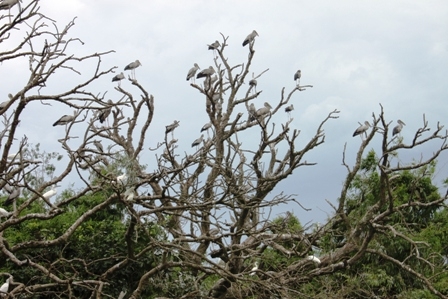The Stork Island in Hai Duong Province is now the home to 16,000 storks and some 5,000 night herons that have been living on the three floating strips of land of the An Duong lake, the place with the most diversified ecosystem in the north.

Departing from Hai Duong City, one should go along the Highway No. 39B to Thanh Mien town, and then go further by 10 more kilometers to reach Chi Lang Nam commune and visit the Stork Island.
In the 15th century, the deluges then broke the Luoc River dyke, inundating the earth mound and the temple in the An Duong flood plain. After that, the water did not go down, thus generating a big lake and a small island. Local residents believed that this was the sacred water area which would never dry up. More and more storks came to live on the island, thus creating Chi Lang Nam Stork Island.
The stork island has been well known as the area with diversified ecosystem with 170 flora and fauna species.
In the bird nesting season, from September to the next year’s April, one could see thousands of birds gathering on the island to seek for food. The An Duong Lake is also the place for a lot of fishes, including the original ones weighing more than 30 kilos.
There are also many other aquatic creatures including shrimps, crabs, frogs and tortoises, some of which are listed in the Vietnam’s Red Book. The vegetation here is mostly the trees for shading and serving as the place for stocks to gather.
According to Nguyen Van Khang, a scientist from the Hai Duong Pedagogical Junior College, who is considered the first person discovering the ecological value of the stork island, this is the natural reserve with a high biodiversity; the only one which has been preserved intact in the north.
In fact, the storks have several homes, including the Lang Giang stork garden in Bac Giang province, the Lap Thach Garden in Vinh Phuc or Dong Xuyen garden in Bac Ninh province. However, it is very difficult to protect the stocks there from the poachers.
Meanwhile, the storks on Chi Lang Nam Island have been sternly protected by local residents over the last many years. This allows the ecosystem here develop in a stability and attract more creatures to come here to settle down, enriching the local ecosystem.
Scientists have pointed out that the biological value of the stork island not only lies in the products people can collect in the locality, such as eggs, fishes, meat and vegetables, but also in the landscape, environment, land and water protection for scientific research and tourism purposes.
However, after 10 years of exploiting the land area for tourism purpose, the ecosystem in the stork island has been seriously degrading.
In July 2009, Thanh Mien district made public the program on the stork island development on an area of 67 hectares. Under the program, capitalized at 83 billion dong, the area would be divided into three main areas, including the stork protection area, the transitional area and the tourism site.
Nevertheless, no investment item has been implemented over the last three years, because the local authorities still have not found reasonable investors and the budget for the program development.
As a result, the land has been overexploited for tourism services, which has had negative impacts on the natural environment.